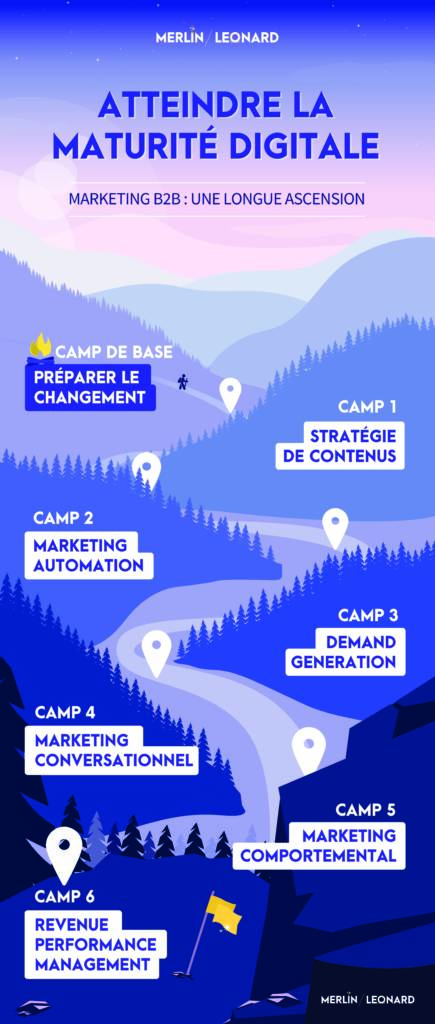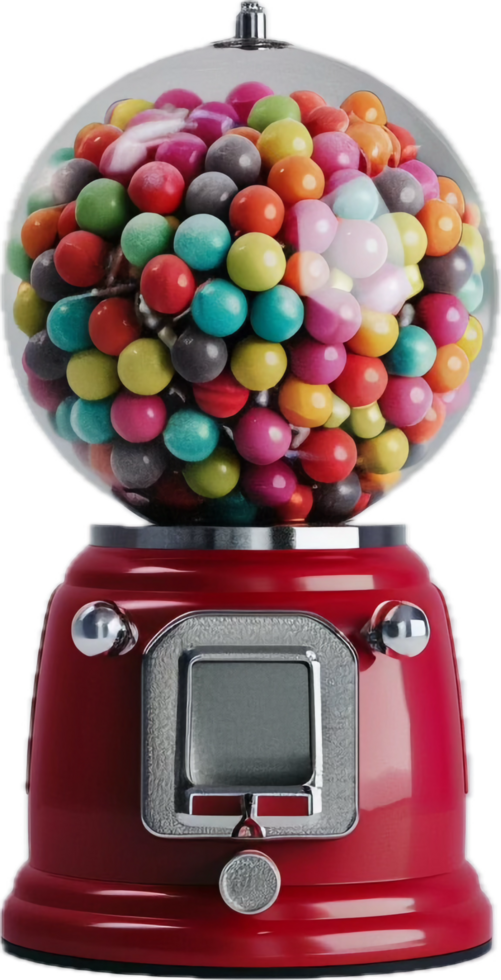For a few years now, conversational marketing has been a new inbound marketing tool for brands and companies. But what is this UFO that puts the customer relationship at the center of the game? More than just a trend, it is one of the most effective levers for improving conversion and ROI.
Between definition, stakes and advantages, Merlin/Leonard helps you understand the interest of investing in a conversational marketing solution.
Understanding conversational marketing: definition
If you analyze conversational marketing in terms of the maturity of a company’s digital marketing, it is almost at the end of the chain. Indeed, when a brand launches its rocket, it starts with outbound marketing, notably with mass emailing to ensure a good take-off.
Then comes the inbound marketing phase, with the implementation of a content strategy, customer relations on social networks and marketing automation.
From the moment prospects start looking for information on a brand’s website, filling out a contact form, then downloading a brochure or white paper, the beginnings of a conversation start.
What about conversational marketing? Well, it’s simply the amplification of this movement, through a digital conversation that will create a relationship in almost real time, at the initiative of the prospect.
What is conversational marketing?
The definition of conversational marketing is quite simple. It is a set of strategies and tools that will promote the engagement of prospects and customers, through the management of a conversation on different digital channels.
Conversational vs. relational: a false debate?
At Merlin/Leonard, we believe that conversational marketing is simply the 2.0 version of relationship marketing. The only difference would be the initiator of this conversation: the customer on one side and the brand on the other. But at the time of the GDPR, this question is no longer relevant!
The new uses of digital are making conversational marketing evolve thanks to the massive use of social networks. These are indeed privileged places of conversation between a brand and its customers. And for a few years now, this relationship has also been developing thanks to other tools, backed by artificial intelligence. This is notably the case of chatbots.
More immediacy and interactivity
Conversational marketing tools allow customers to converse with a brand wherever and whenever they want. Let’s imagine that Leonard wants to contact Merlin at 11:30 pm, to ask him a question before going to sleep, and then resume the conversation with his morning coffee. He needs to get an answer when he wakes up and be able to continue the conversation in real time, if he wants to.
This is one of the challenges of conversational marketing: offering real interactivity and more instantaneous answers, even outside of “working hours”.
Another example: Lancelot is on your most beautiful offer page, and has a question, right now. He would like to have an immediate answer, not sure if the contact form is the solution in this case.
An omnichannel communication
One of the advantages of conversational marketing is that customers come to you and not the other way around.
This omnichannel conversation can start on Messenger or Facebook, then continue via any other channel, keeping the history of the flows and conversations!
Thus, the prospect can continue the discussion via :
- a chat bot on your website,
- a mobile quiz solution,
- an interactive terminal at the point of sale, etc.
What are the objectives of conversational marketing?
Conversational marketing is – in theory – downstream of outbound and inbound marketing actions. So you have – again in theory – already measured the engagement rate of outbound campaigns and the conversion rates along your funnel.
As you probably already know, today’s Internet users are looking for immediate answers to their questions about an offer, a product or a brand. Therefore, one of the main objectives of conversational marketing is not to lose these visitors.
We could say that the ultimate goal of conversational marketing tools is always to increase the conversion rate, by accompanying the customer in his buying journey. The objective is to eliminate, in near real time, all the obstacles to purchase.
The chatbot example
Because it is available 24/7, a chatbot can be a powerful marketing tool to enhance the buying process. To do this, it must be able to answer questions, share information and direct the customer to the right offers or services at the right time. In addition to the constantly available customer support, the chatbot improves the progression of prospects within the funnel.
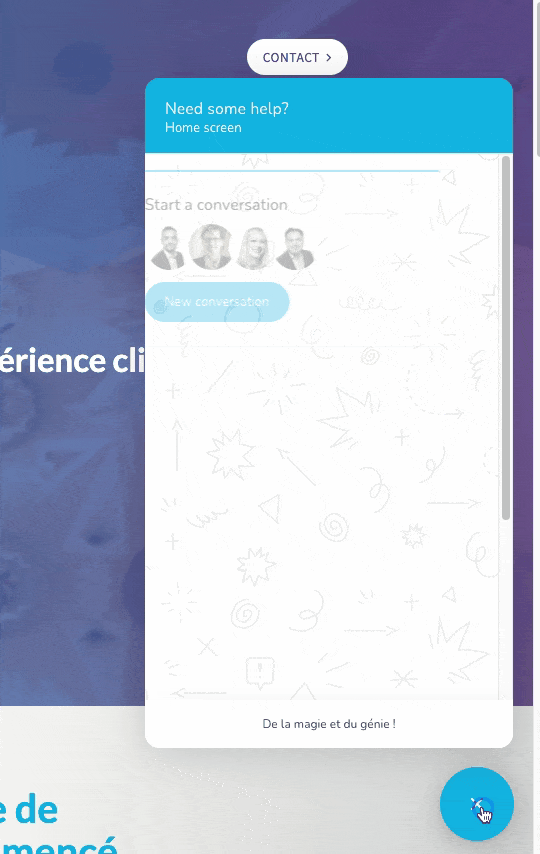
The different objectives according to the position in the funnel
The objectives of conversational marketing also depend on the position of the prospect in the funnel. Here are some examples:
- Awareness: the objective is to attract the visitor by offering personalized content during the first contact. For example, pushing your “Finance and Insurance” white paper to a person in this sector.
- Acquisition: the objective is to increase conversion with interactive content (quizzes, calculators, chatbots, etc.);
- Activation: using the same tools as in the acquisition phase, we will try to trigger an action that favors the purchase;
- Revenue: the objective is typically to increase sales by making the process more fluid thanks to the conversation;
- Retention: the customer must be able to quickly find the answer to his problem, 24/7.
- Referral: the objective is to be able to assist the satisfied customer to transform him into an ambassador, or to defuse a conflict with a detractor to reduce his reach.
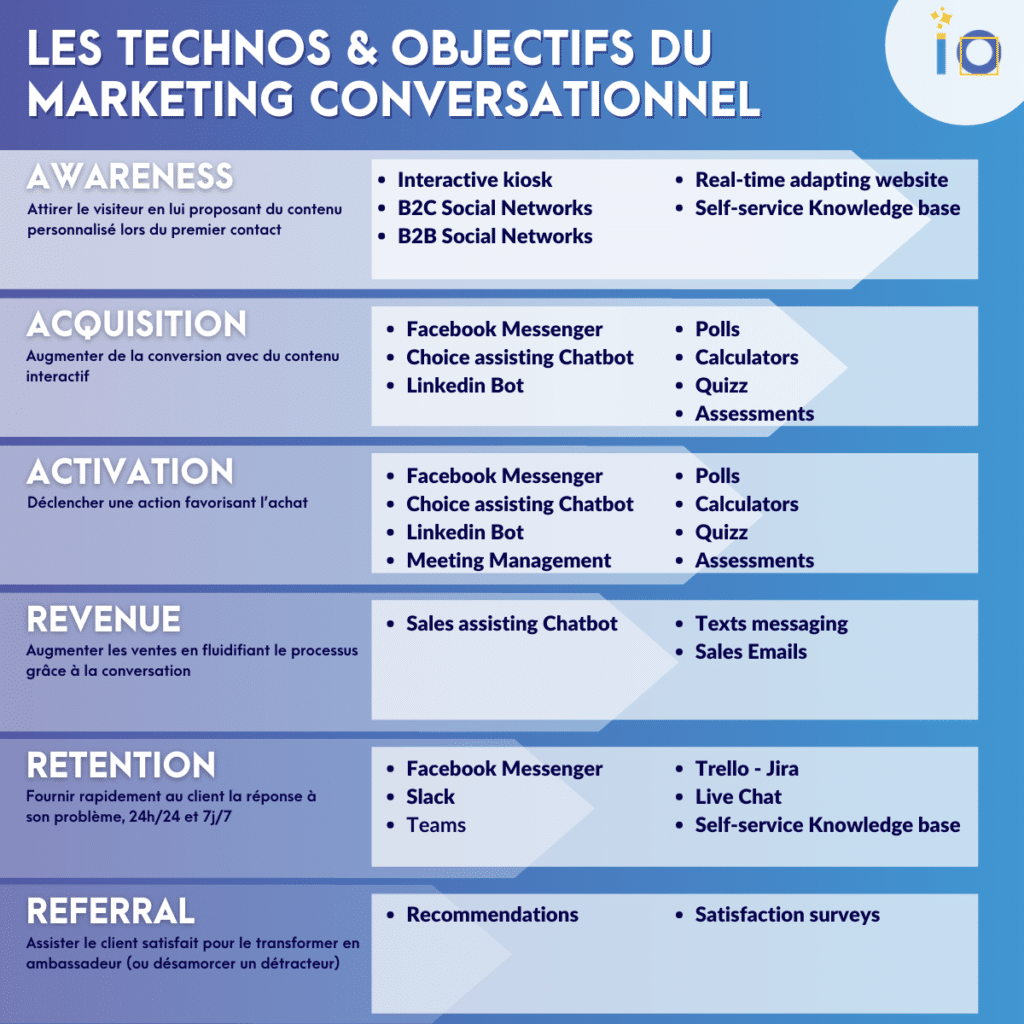
What are the components of conversational marketing?
In conversational marketing, it is always the prospect who initiates the conversation. He is the one who drives the exchanges and who chooses to enter into a relationship or to accept to use such or such tool.
This customer-centric strategy must make the customer feel unique. He must then be put in confidence to allow the construction of a real relationship. Finally, they must also be able to contact you at any time, via the channel and/or tool of their choice.
Thus, each conversation is personalized and contextualized. The challenge is always to arouse the customer’s interest, by providing them with the appropriate answers or by proposing relevant content.
The personalization and the relevance of the answers given are very important and require a perfect knowledge of the context of the contact. If your chatbot or your team doesn’t know the context of the request, they will have to ask the same questions for each interaction.
For example: I will not ask the same questions to a new prospect as to a known customer with whom I already have a long history.
Finally, the conversations must be scalable. Indeed, the prospect or customer doesn’t care if you have 10, 100, 1000 or 10000 requests at the same time. What they want is for the brand or company to meet their needs.
As you know, today it is impossible for a small structure to access all the requests in real time. This is one of the other advantages of conversational marketing: making a service available 24 hours a day thanks to different digital tools.
What are the differences between B2B and B2C?
On e-commerce sites, there was very early on this desire to help consumers make their purchase right away, to promote a shorter sales cycle. Customer relationship has been at the center of the approach for a long time and conversational marketing allows to answer quickly to the slightest question of the Internet users.
In B2B, instantaneousness in the purchase cycle is less obvious, since it is generally part of a longer time frame. It is only when certain needs or requests crystallize that conversational marketing is invited into a B2B path. This is why dedicated technologies and tools are less developed in this sector today.
What can conversational marketing do for you?
According to Gartner, by 2022 more than 70% of employees will come into contact with a conversational platform on a daily basis. Do you now understand the importance of investing in this inbound marketing strategy?
This new mode of interaction, because it is more fluid and instantaneous, is much more engaging than any other communication channel. It allows you to create a direct dialogue in real time, which will reinforce the customer experience by encouraging customer involvement.
A better customer experience means more engagement and sales, and therefore a better ROI (return on investment). With the advent of social networks and instant messengers such as Whatsapp or Messenger, conversational marketing has a bright future ahead of it.
And if conversational commerce still relies mostly on the use of chatbots, many other tools can help you improve your customer knowledge. We’ll talk about them later.
Finally, don’t forget that today it is the most efficient tool to accompany prospects in your funnel and convert them. It is now up to you to jump on the bandwagon and offer your future customers a more interactive 2.0 experience that brings real value.
What are the KPIs to follow in conversational marketing?
Here are the 8 essential metrics to track to measure the performance of your conversational marketing strategy:
- The usage rate and the number of conversions to understand if the answers provided are relevant;
- The retention rate to measure customer satisfaction;
- The duration of the exchange and the number of messages exchanged to qualify the conversation;
- The activation rate or how the user’s engagement impacts a sale or the level of customer knowledge;
- The success rate of the chatbot in relation to the business objectives;
- The failure rate of option proposal: when the robot is not able to propose a solution adapted to the request;
- The confusion rate or the number of conversation abandonment in case of unsuitable answer or redirection;
- The bounce rate, which reflects the number of connections without any interaction.
2 successful examples of conversational marketing
The chatbot Messenger of Oui.sncf is certainly one of the most famous examples of conversational marketing. Vbot allows you to book your ticket directly via the chat application and to finalize the purchase process via Messenger. The technology is also deployed on the brand’s website.
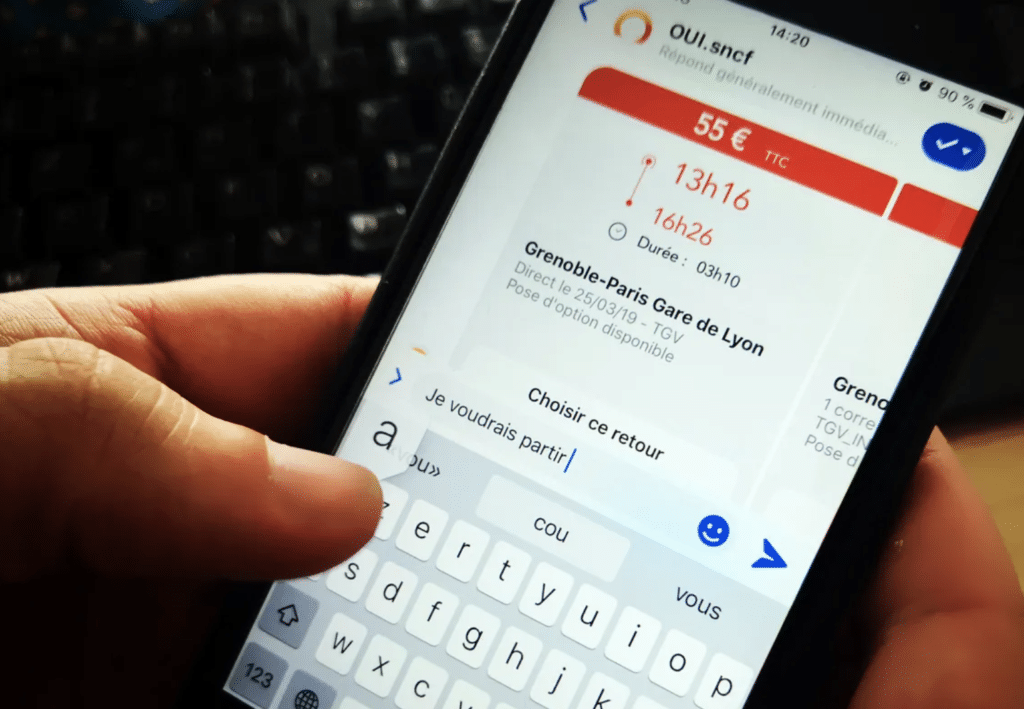
Another example of a successful application is the Sephora chatbot that offers its customers to answer a quiz to learn more about their beauty habits. Depending on the answers given, the robot offers the customer adapted content: video tutorial, blog article, product page,…
Conclusion
If the possible applications of conversational marketing already seem numerous, the high-speed development of Artificial Intelligence should make this technology even more powerful. Eventually, conversational marketing solutions and tools will become truly indispensable for companies and brands. It’s time to get started, don’t you think?
Merlin/Leonard will help you deploy your conversational marketing, marketing automation or growth hacking strategies. Don’t hesitate to contact us to learn more.



